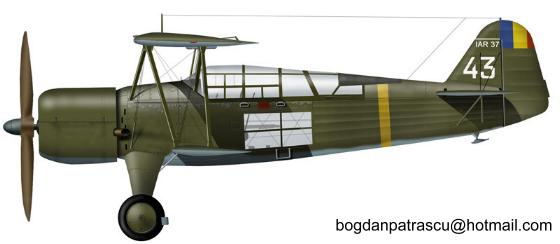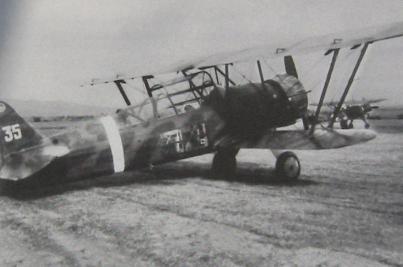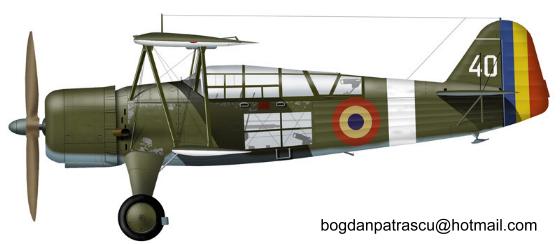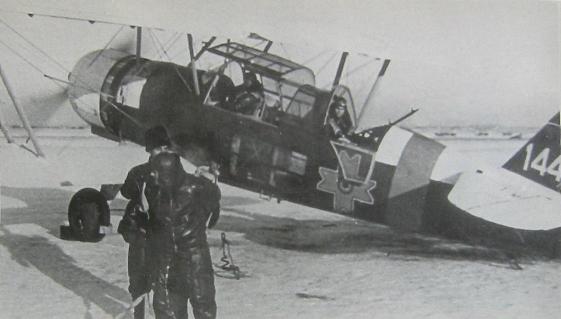|
In 1936, IAR produced a new project for an observation and light bomber plane designated
as IAR-37. Derived from the French Potez 25, the project was fitted by the IAR 14K (a French Gnome-Rhone sublicensed engine). Though, the prototype IAR-37.1 made its first test in spring 1937 with good results. A contract was signed with the Ministry of the Air and Navy and until the end of 1937, 50 planes were delivered. In summer 1938 the IAR designers proposed the available BMW-132 engine and after some modifications on the fuselage, the plane was renamed IAR-38 and the production continued with 75 more planes used only for observation/reconnaissance duties. In November 1938 the new IAR 14K IIC-32 engines were available and 49 IAR-37 received it, but due to some structural problems the IAR plant brought some modifications to the initial project. The resulted plane, named IAR-39 made its first tests in March 1940 and 95 were produced until the end of the year. From 1942 production was transferred to the SET plant in Bucharest where the IAR 39A received a mended engine: the IAR 14K IV C. Production stopped in late 1944 after 160 aircraft were produced. Each SET produced IAR received an “S” added to its serial number.
The observation squadrons started to receive the first IAR-37s in 1939 and by the end of 1940 three observation groups were entirely equipped with the IAR-37/38/39 aircraft.
From the beginning of the Barbarossa campaign to attack enemy troops, artillery positions, convoys, AA machine-guns or for anti-partisan duties behind the front line. The IAR-38 and 39 squadrons were attached to every corps or army command and were used to observe/photograph the front line and enemy troops movements. In total 11 squadrons (11th, 12th, 13th, 14th, 15th, 16th, 17th, 19th, 20th, 21st and 22nd) and one light bomber squadron (18th). The first loss came on the very first day of the war when an IAR-37 from the 19th Observation Squadron was shot down by a VVS I-153. Two days later the rear gunner (sgt. Vasile Puscasu) of an IAR 39 from the 22nd Observation Squadron shot down an I-16 Rata. During the first campaign 30 IAR-37/38/39 were lost.
In 1942 one light bomber and six observation squadrons were used in the Stalingrad campaign from September 1942 to January 1943. 13 IAR-38/39s were lost in that period.
During 1943 most of the IAR-38/39s were used mostly for reconnaissance over the Black Sea coast or escort of the convoys between Constanta, Odessa and Sevastopol and as approach reconnaissance for army duties.
In 1944, the majority of the IAR-39s were committed to the front in 9 observation squadrons and the remaining IAR-37s equipped the 7th Light Bomber Group. After the events in August, two observation squadrons equipped with 24 IAR-39s from the 2nd Observation Group fought in the Transylvanian campaign. The 1st Observation Group (also with two squadrons) soon joined. it During the fights ten IAR 39 were lost. The old biplanes continued to fly during the continued offensive into pre -1940 Hungary, Slovakia and then the Czech Republic. Due to the lack of fighters, the IARs performed well but had several casualties to the AAA fire. The last IAR 39 loss in WWII was on 8 May 1944 near Voderady in Eastern Moravia. The last mission flown by a ARR IAR-39 was on 9 May, when an aircraft dropped leaflets and observed the surrender of German troops.
Beside its utilization on the front line, few IAR-38s were used as trainers for the preparation of the future crews of Ju 87D and from November 1943, some IAR-37s and 39s were used for towing the DFS-230 gliders of the 109th Transport Squadron.
After the war, the survivors of the IAR-37/38/39 family received civilian codes and were used until the early 1960s. Unfortunately none were preserved to our days. Despite its vulnerability, low speed and total lack of armor, the IAR-37/38/39 aircraft, nicknamed “Mos Neata”, were used by the ARR from the first to last day of the war. It was very much loved by the infantrymen on the ground, who always felt safely with the old biplane watching over them and directing the artillery fire.
The IAR-37

Profile courtesy of
Bogdan Patrascu
| Wingspan |
12.22/10 m |
| Length |
9.5 m |
| Height |
4.09 m |
| Weight (empty) |
2219 kg |
| Weight (bomber) |
3435 kg |
| Weight (recon) |
3060 kg |
| Maximum speed at 3200 m |
335 km/h |
| Climbs to 4000 m |
8 min. 30 sec. |
| Maximum operational ceiling |
8000 m |
| Range |
650 km |
| Engine |
IAR 14K II c32 870 HP |
| Machine-guns |
4x7.92 mm Browning PWU |
| Bombs |
12x50 kg |
| Serial numbers |
1-50 |
The IAR-38

Picture from "Rumanian Air Force, the prime decade 1938-1947" by Dénes Bernád, Squadron/Signal Publications, 1999
| Wingspan |
12.22/10 m |
| Length |
9.52 m |
| Height |
4.09 m |
| Weight (empty) |
=2219 kg |
| Weight (bomber) |
=3435 kg |
| Weight (recon) |
=3060 kg |
| Maximum speed at 3200 m |
220 km/h |
| Climbs to 4000 m |
=8 min. 30 sec. |
| Maximum operational ceiling |
7000 m |
| Range |
680 km |
| Engine |
BMW 132A 700cp |
| Machine-guns |
4x7.92 mm Browning PWU |
| Bombs |
12x50 kg |
| Serial numbers |
1-75 |
The IAR-39

Profile courtesy of
Bogdan Patrascu
| Wingspan |
13.10/10 m |
| Length |
9.6 m |
| Height |
4.09 m |
| Weight (empty) |
2177 kg |
| Weight (bomber) |
3085 kg |
| Weight (recon) |
3007 kg |
| Maximum speed at 3200 m |
330 km/h |
| Climbs to 4000 m |
7 min. 50 sec. |
| Maximum operational ceiling |
8000 m |
| Range |
680 km |
| Engine |
IAR 14K II c32 870 HP |
| Machine-guns |
4x7.92 mm Browning PWU |
| Bombs |
24x12 kg |
| Serial numbers |
1-95 |
The IAR-39A

Picture from "Rumanian Air Force, the prime decade 1938-1947" by Dénes Bernád, Squadron/Signal Publications, 1999
| Wingspan |
13.10/10 m |
| Length |
9.6 m |
| Height |
4.09 m |
| Weight (empty) |
2177 kg |
| Weight (bomber) |
3085 kg |
| Weight (recon) |
3007 kg |
| Maximum speed at 3200 m |
336 km/h |
| Climbs to 4000 m |
7 min. 18 sec. |
| Maximum operational ceiling |
8000 m |
| Range |
680 km |
| Engine |
IAR 14K IV c32 1025 HP |
| Machine-guns |
3x7.92 mm Browning PWU |
| Bombs |
24x12 kg |
| Serial numbers |
96-255 |
|